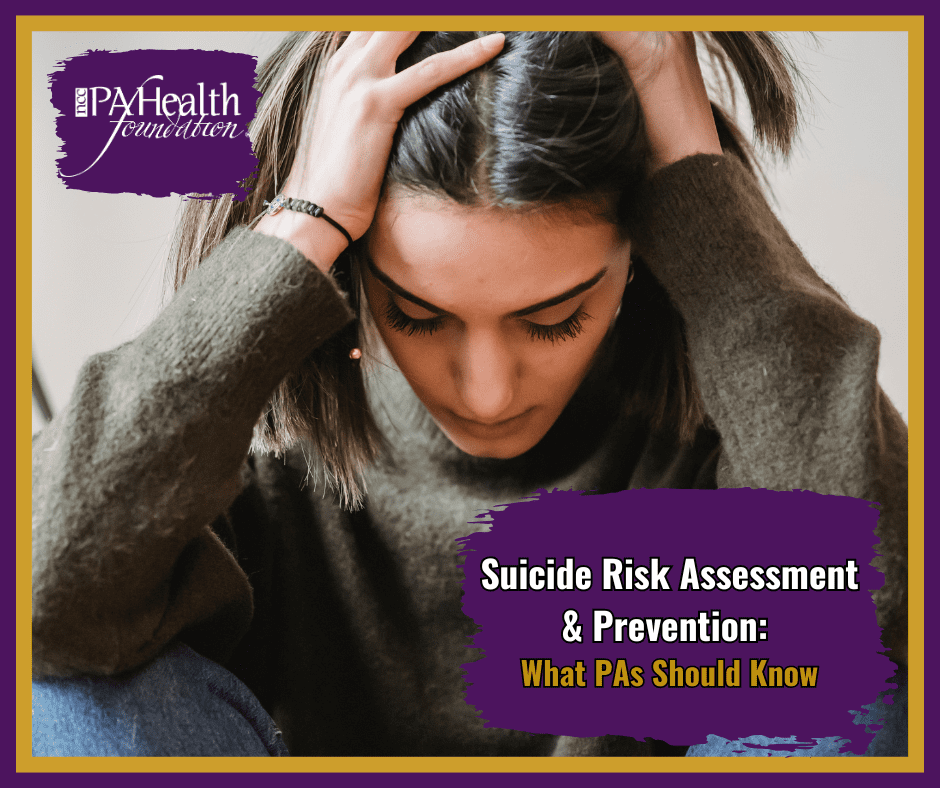Suicide Risk Assessment & Prevention: What PAs Should Know
According to the Surgeon General’s Call to Action to Implement The National Strategy for Suicide Prevention (2021), suicide is one of the leading causes of death in the United States, claiming over 49,000 lives in 2023. In 2022, suicide was the second leading cause of death among individuals between the ages of 10-14 and 25-34. It was the third leading cause of death among individuals between the ages of 15-24, and the fourth leading cause of death among individuals between the ages of 35-44. Suicide rates are rising across the country, with a national suicide rate increase of 32% from 1999 to 2019. Additionally, for every person who dies by suicide, thousands more experience suicidal thoughts or attempt suicide.
Suicide is a complex reaction that is influenced by many different factors…and it is preventable. With more than 189,000 Board Certified Physician Assistants (PAs) in the United States engaging in more than eleven million patient encounters every week, PAs are in a unique, critical position to assess for and respond to suicidal risk when providing services to children, adolescents, and adults.
Below are general guidelines all PAs can adapt when conducting a suicide risk assessment:
- Establish rapport and trust: Create a safe and non-judgmental environment where the patient feels comfortable sharing their thoughts and feelings. Show empathy and actively listen to their concerns.
- Ask direct questions: In a compassionate manner, ask direct questions about suicidal thoughts or intentions.
- Assess risk factors: Evaluate the presence of risk factors that contribute to suicidal ideation such as mental health disorders, previous suicide attempts, a family history of suicide, recent losses or traumatic events, substance abuse, social isolation, access to lethal means, or a lack of support systems.
- Identify protective factors: Explore the patient’s personal strengths, coping skills, and resources that may act as protective factors against suicide. These may include supportive relationships, access to mental health services, effective problem-solving abilities, religious or cultural beliefs, or a sense of purpose.
- Evaluate suicidal ideation: Assess the frequency, intensity, duration, and specificity of the patient’s thoughts about suicide. Determine if they have formulated a plan, the level of intent, and whether any preparatory actions have been taken. Consider using a screening tool, such as the Columbia Suicide Severity Risk Scale (C-SSRS).
- Assess current emotional state: Evaluate the patient’s emotional state, including symptoms of depression, hopelessness, anxiety, irritability, or feelings of being trapped. Determine if they are experiencing any immediate distress or acute crisis.
- Explore help-seeking behavior: Assess the patient’s willingness to seek help, and their engagement in any previous treatment or therapy. Determine if they have reached out to their support network or other mental health professionals.
- Collaborative safety planning: Develop a collaborative safety plan with the patient, focusing on strategies to manage the immediate crisis and steps to take if suicidal thoughts intensify. Include information such as emergency contacts, support systems, coping strategies, and professional resources.
In addition, PAs can access online resources to learn more about suicide risk assessment, screening, and prevention. Coordinated efforts are needed to tackle this urgent and growing public health crisis that sees approximately 1 person complete death by suicide every 11 minutes, and PAs are equipped and ready to be an integral part of those efforts.

Resources & References
- Surgeon General’s National Strategy Call to Action – sprc-call-to-action.pdf
- 2024 National Suicide Prevention Strategy Website – 2024 National Strategy for Suicide Prevention | HHS.gov
- 988 National Suicide Prevention Hotline – 988 Lifeline – Available 24/7/365 in English and Spanish.
- Evidence-Based Prevention Strategies – Improving Suicide Prevention Through Evidence-Based Strategies: A Systematic Review | American Journal of Psychiatry
- NIMH Suicide Screening Toolkit – Ask Suicide-Screening Questions (ASQ) Toolkit – National Institute of Mental Health (NIMH)
- SAMHSA SAFE-T Suicide Assessment – SAFE-T Pocket Card: Suicide Assessment Five-Step Evaluation and Triage (SAFE-T) for Clinicians | SAMHSA
- C-SSRS Suicide Assessment – A Simple Set of 6 Questions to Screen for Suicide | Columbia University Department of Psychiatry
- SAMHSA Suicide Prevention Resource Center Video – Effective Suicide Prevention – Suicide Prevention Resource Center

